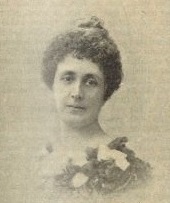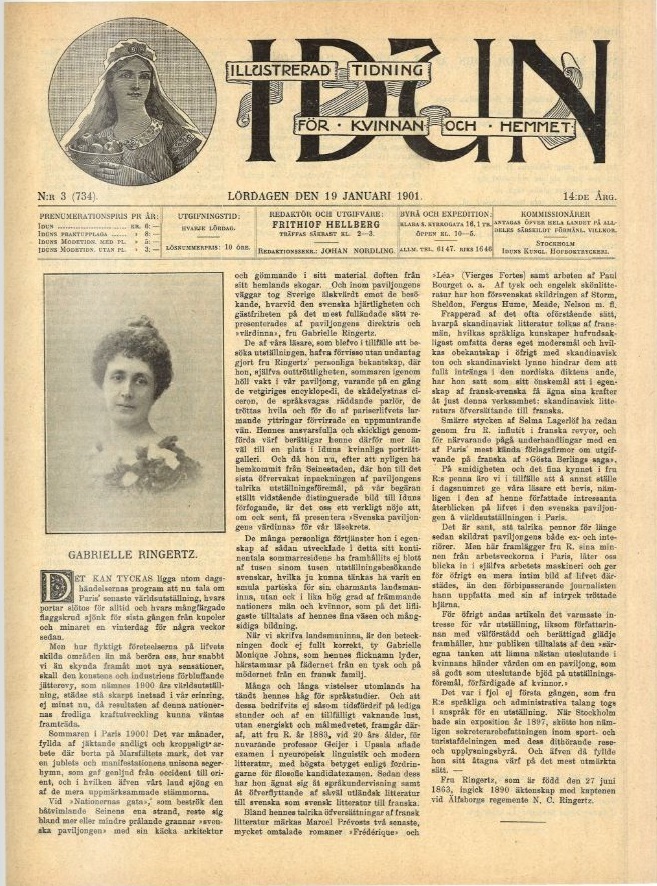Information about Gabrielle Ringertz is scarce. She was born in 1863 and married in 1890 to a military officer who advanced to colonel’s rank. In the spring of 1917, Hasselbladfilm, the Gothenburg-based competitor to Svenska Bio, led by director Georg af Klercker, announced a script competition. 250 entries were submitted, but the results did not meet with the expectations. No first prize was awarded, but a second prize was announced ex aequo between one law clerk Helge Berglund and “Madam Colonel” Ringertz.
The manuscript of the former was never realised, but in the autumn of 1917, af Klercker had his long-time assistant Manne Göthson taking on Ringertz’s manuscript, which was turned into the film Storstadsfaror (“Big city dangers”, 1917), starring Mary Johnson, one of the big names of the period. It was a typical af Klercker era melodrama about young girls who end up in unfortunate circumstances in the big city, but in this case are rescued by the Salvation Army as well as a childhood friend returning from the United States having made his fortune over there. A wedding in the same church where the two childhood friends committed their confirmation provides a rosy final chord.
The critics noted the heart-warming social message but were otherwise lukewarm towards both direction and script. No more screenplay came out of Ringertz’ hands, but on occasion she would call herself a writer and she very likely also wrote short stories for various weekly magazines, sometimes under the signature Monica Bang.
Bengt Forslund (2015)
Editor’s supplement:
An article about Gabrielle Ringertz in the magazine Idun (vol. 14, no. 3, 1901) shows that she was the director and hostess at the Swedish pavilion at the 1900 World’s Fair in Paris. She is described in wonderfully overflowing terms: “Those of our readers who have had the opportunity to visit the exhibition have certainly without exception made Mrs. Ringertz’s personal acquaintance, where she, tirelessness personified, kept watch in our pavilion throughout the summer, being at once the encyclopaedia of the curious, the cicerone of the spectators, the aiding parlour of the weak of foreign tongue, the rest of the weary, and for those nonplussed by the razzle-dazzle of Parisian urban life, an encouraging friend.”
The family on the father’s side came from Germany, and on the mother’s side from France. According to the article, Ringertz herself travelled on “many and long stays abroad” which are said to have aroused her interest in language studies. At the age of 20, in 1883, she graduated with a bachelor’s degree in philosophy with the highest grades in new European linguistics and modern literature. After that she worked with both language teaching and translation of foreign literature into Swedish and Swedish literature into French. Among the authors whose works she translated into Swedish are Marcel Prévost and Fergus Hume. She also translated works by Selma Lagerlöf for the French market.
(2022)
(Translated by Jan Lumholdt)
Basic info
Main professions: Author, Screenwriter
Born: 1863
Died: 1945
Active: 1902-1939
Published works
Virgines (Ljus, 1902) (under pseudonymen Monica Bang)
Offereld (Geber, 1904) (under pseudonymen Monica Bang)
Inkräkterska [roman] (Bonnier, 1910)
Sojourn for young ladies at different bathing resorts and other places in France … under the management of M:me Gabrielle Ringertz (1924)
Från min balkong i Madrid (Hökerberg, 1931)
Mina vänner irländarna (Hökerberg, 1933)
Cyrnos: medelhavsstämningar (Hökerberg, 1935)
Havets land: Bretagne (Medén, 1936)
Guds barnbarn (Medén, 1936) (under pseudonymen Monica Bang)
På vita vägar i Provence (Bonnier, 1939)
Awards
Delat andrapris i Hasselblads Fotografiskas stora manuskriptpristävling 1917 med manuskriptet till filmen Storstadsfaror (för vars manus hon är krediterad).

